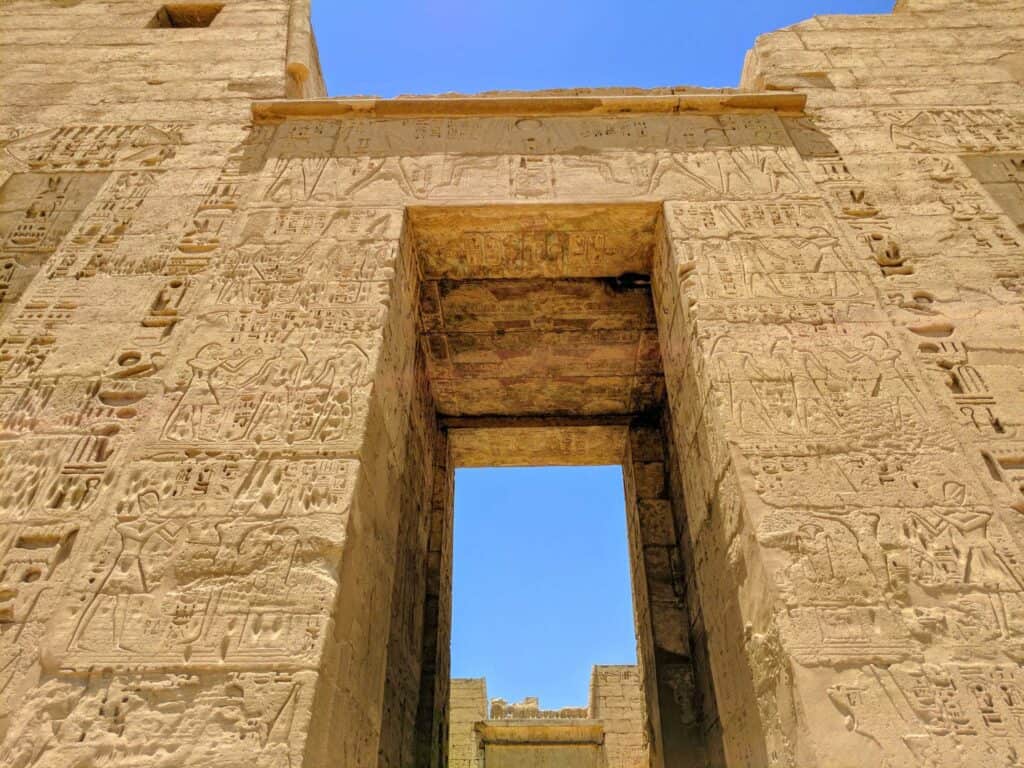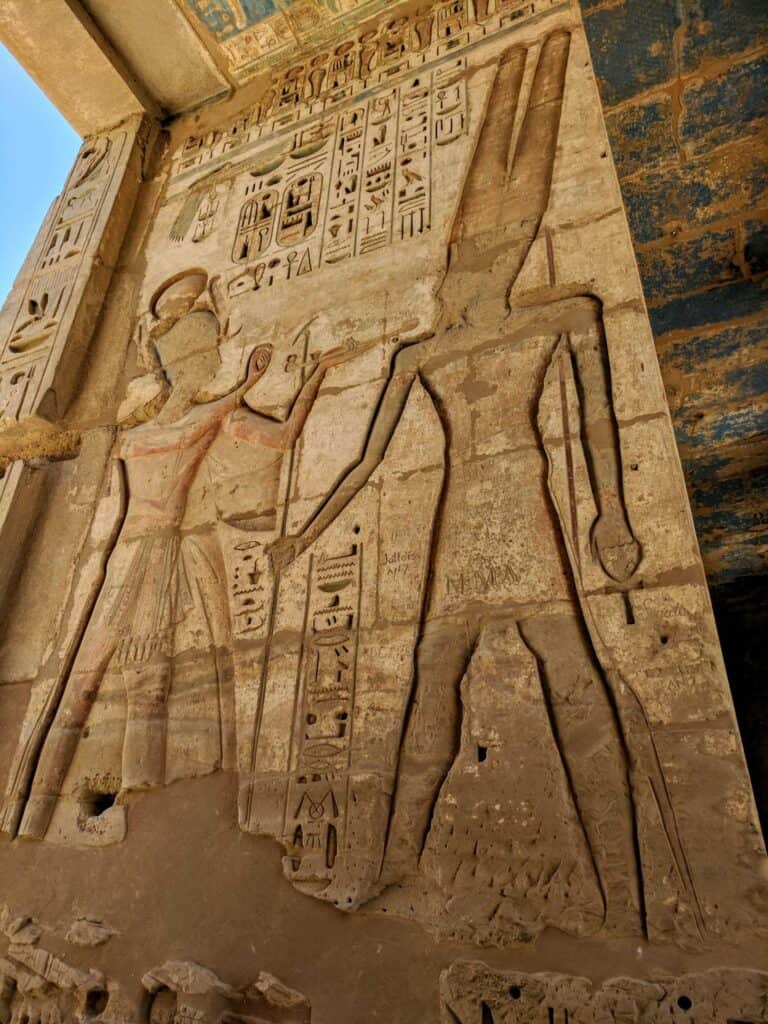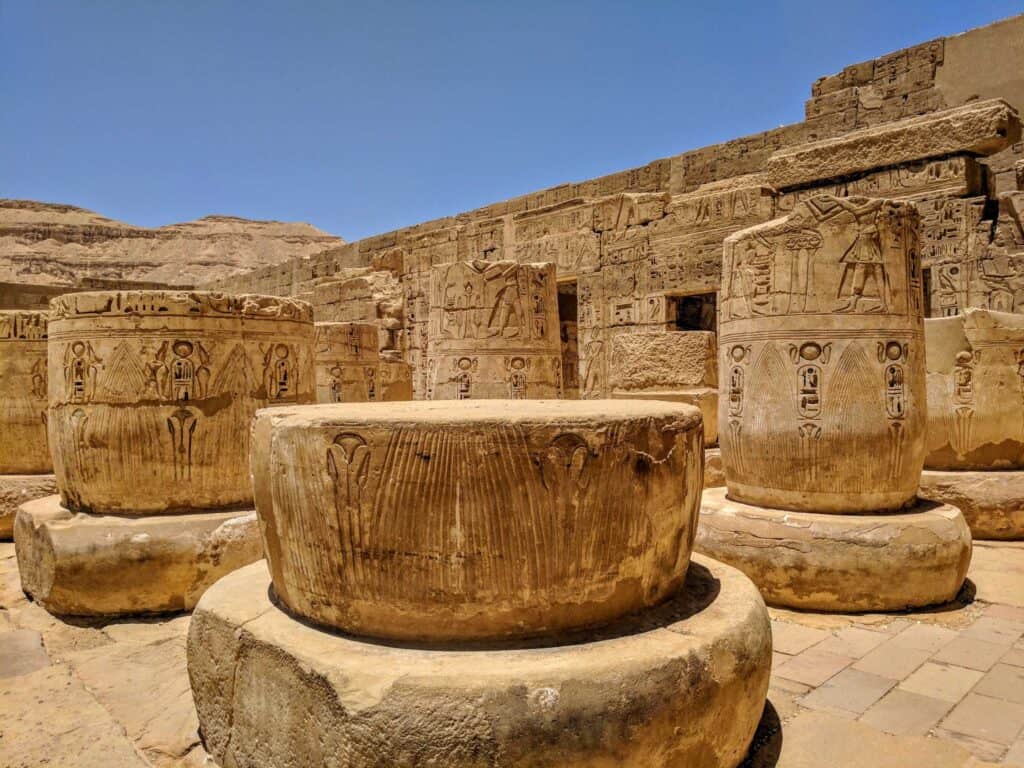Luxor is one of the most important places to visit in Egypt. We automatically think of fabulous archaeological sites such as the Luxor Temple, the Karnak Temple, the Valley of the Kings, the Temple of Hatshepsut, and the Colossi of Memnon.
On the west bank, a historical treasure goes unnoticed by many tourists and is ignored by most travel agencies: the Temple of Medinet Habu. One of my favourite temples in Egypt, it was erected for mortuary services to Ramses III. For this reason, people also call it the Mortuary Temple of Ramses III.
I’m surprised, Damas! The Great Ramses III! Besides the famous temple connected to him in Abu Simbel, I’ll have this temple to visit in Luxor!
I love your excitement, but don’t confuse Ramses II with Ramses III.
The magnificent temple at Abu Simbel is linked to Ramses II. Medinet Habu is connected with Ramses III (or Ramesses III), another pharaoh of enormous historical importance. By the way, it is his mummy that appears in the opening image of this post.
Ramses III, one of the last great pharaohs of ancient Egypt, was the second pharaoh of the 20th Dynasty and the last great ruler of the New Kingdom. He reigned from 1186 to 1155 BC and faced many challenges from foreign invaders, such as the Libyans, the Nubians, and the Sea Peoples. He defeated them all in decisive battles and recorded his achievements on temple walls and papyri. Ramses III also built many monuments and temples, and the temple at Medinet Habu is one of the most prominent.
With lots of photos, I’ll show you the experience of visiting the Medinet Habu Temple. I hope The Great Ramses III will join us now. Ramses II can come too if he wishes.
The visit
Tourists usually arrive here after visiting the Colossi of Memnon, only 1.1 km (0.68 miles) away. They suddenly see this exciting scene:

A few steps ahead, we turn left and discover the entrance gates. There are the remains of a fortified tower, also known as a migdol.

The area to be visited is enormous — only the Karnak Temple is bigger. So, our heart races. What are we about to see? How excited will we be? After all, we have learned that Egypt is always ready to exceed our expectations.
You can understand this better by observing a photo published by the renowned archaeologist Zahi Hawass on social networks:

Incredible structure! Based on the photo, imagine the temple’s complete form, with the ceiling, massive columns, and walls. That’s why it served as a shelter for the population of Thebes during the invasions in Egypt in the 20th Dynasty.
Reading Break
Going to EGYPT? Make your dream trip happen in the best way possible, with personalized itineraries in PRIVATE or SMALL GROUP mode. Check out my official partnership with one of the most famous agencies in the world, specializing in Egypt. Since 2008, I’ve been helping and inspiring (with transparency) people to visit the Pharaonic lands. Learn more.
Enter the temple with me
Before entering the temple, I have a warning for you. If the visit happens in spring or summer, don’t forget a bottle of water, sunscreen, sunglasses, and a hat. Wearing comfortable shoes is also essential. (Read later about thermal water in Egypt.)
Ready?
Feel the euphoria of crossing the entrance gate. Go slowly, appreciating everything. I’m right at your side.

We’re talking about Ramses III, not Ramses II.


Dazzled, we feel the energies of Ramses III, crossing large, open courtyards and admiring statues, paintings, ornate columns. Medinet Habu is also known for its incredible reliefs, including scenes of the pharaoh celebrating military victories and scenes from religious ceremonies.
The first pylon (next photo) leads to an open courtyard. One side is full of columns; the other features statues of Ramses III as Osiris. The second pylon leads to a peristyle, also with images of Ramses III. Finally, we arrive at the third pylon via a ramp into a columned portico, which opens into a large hypostyle (room with columns supporting the roof). Sadly, the roof of this hypostyle has collapsed.
One of the most stunning details is the vivid colours in some paintings. Interestingly and ironically, the early Christians in Egypt helped to preserve the colours. They converted the area into a church and used plaster to cover the “offensive paintings.”
The colours hypnotise me. I see the artists working there. Perhaps they never imagined their creations would be appreciated thousands of years later — ready for the Eternity the ancient Egyptians so yearned to reach. (I remember now the excitement of seeing the colourful paintings on the walls of Tutankhamun’s tomb in the Valley of the Kings.)









This temple is an unforgettable surprise for tourists in Luxor.







Where
You already know that this Egyptian treasure is in Luxor. See the following map to understand its location based on other famous touristic sites.

The green arrow points to the Valley of the Kings. The blue arrow, the Temple of Hatshepsut. The orange arrow, the Colossi of Memnon. Finally, the red one shows the Medinet Habu Temple. (That’s why I said the visit to Medinet Habu usually happens after going to the Colossi of Memnon.)
Locate the temple now on Google Maps.
Extra: The Screaming Mummy
The identity of the famous Screaming Mummy found in the Valley of the Kings was a mystery for many years. If the body has signs of nobility and was found in a noble burial place, why does it show evidence of contempt during its mummification process? Why the brain and the viscera were not removed? Why wrap the mummy in sheepskin instead of fine linen? Why an insignificant wooden coffin with no identification? Above all, why the “expression” of agony and scream?

The series of questions get answers after forensic analysis and DNA testing.
It is believed that this is the mummy of the son of Ramses III and that he was part of the plot to murder his father. Sentenced to death, he was buried with extreme contempt. Not having his identification on the casket was perhaps the worst revenge. The ancient Egyptians believed that the identification of the mummy was essential to be recognised in the Hereafter and to continue life in Eternity. Without his name being identified, there would no longer be that possibility.
The expression of agony could be that of the moment of death, but natural causes also explain that. Due to inferior mummification, gravity would have acted on the body, shifting the jaw, skin, and muscles around the eyes downwards. The final look would cause that horrible image.
I’m shocked, Damas! I didn’t know that Ramses III had been murdered. Does his mummy show signs of the cause of death?
Yes. Look again at the photo that opens this article. I already said that the mummy in the montage is the pharaoh. There are fabrics around his neck. They cover the marks of the fatal blow.
May the good pharaohs help us. With no screaming mummies!
G. DAMAS
» I live in Germany, after several years in Portugal (Algarve).
» My first fiction books, for young adults, were published in the early 2000s in Portuguese. I also wrote books and guides about travel and technology. Screenplays are my greatest passion.
» This blog is the English version of my G. DAMAS (Portuguese language, online since 2008). || English is not my native language.
[ More / Contact ]


Hey, leave a comment 🙂